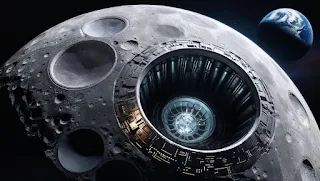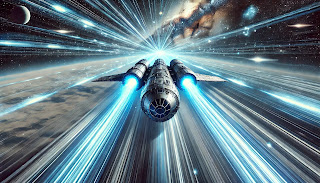The Hollow Moon Theory: Is Earth's Satellite an Ancient Alien Machine?
The Moon as a Machine: Sci-Fi and the Hollow Satellite Theory
Introduction: A Moon of Many Mysteries
The Moon is Earth’s constant companion, always visible, always familiar—and yet, still deeply mysterious. While mainstream science views it as a natural satellite formed from debris billions of years ago, alternative thinkers and storytellers have proposed a far more mind-bending idea: What if the Moon isn’t natural at all? What if it's a machine, a deliberately engineered structure, possibly ancient and alien in origin?
This concept, often referred to as the Hollow Moon Theory, straddles the strange intersection of speculative science, conspiracy theory, and rich science fiction lore. Despite being dismissed by the scientific community, it has captured imaginations for decades, offering a lens through which we explore not just outer space—but the limits of our understanding.
The Hollow Moon Theory: Origins and Foundations
A Soviet Spark of Speculation
The Hollow Moon hypothesis found footing in the 1970s, largely due to the work of Soviet researchers Mikhail Vasin and Alexander Shcherbakov, who posited that the Moon might be a gigantic spacecraft placed in Earth orbit by advanced extraterrestrial beings. Their 1970 article in Sputnik magazine—titled “Is the Moon the Creation of Intelligence?”—suggested that the Moon was too unique, too perfect, to be naturally formed.
NASA’s Apollo Missions and the "Bell-Ringing" Incident
During the Apollo 12 mission, NASA conducted seismic experiments by crashing the Lunar Module's ascent stage into the Moon. The seismic instruments recorded vibrations that lasted for over an hour, leading scientists to describe the Moon as having "rung like a bell." While geologists explained this as a function of the Moon’s dry, rigid interior—very different from Earth’s moist and energy-absorbing crust—alternative theorists interpreted it as evidence the Moon might be hollow or metallic inside.
The Moon as a Machine in Science Fiction
1. Arthur C. Clarke and Alien Monoliths
In 2001: A Space Odyssey, Clarke and Kubrick introduced the idea of a buried monolith on the Moon, planted by alien beings to monitor or influence humanity. The Moon, in this context, isn’t hollow—but it is a stage for cosmic intervention.
2. Transformers: Dark of the Moon (2011)
This blockbuster film treats the Moon as a battleground and secret vault for alien technology. The Apollo missions are reinterpreted as cover stories to investigate a Cybertronian spacecraft—a massive, dormant machine hidden on the dark side.
3. Moonfall (2022)
In Roland Emmerich’s disaster sci-fi Moonfall, the Moon is revealed to be a megastructure built by a technologically advanced human civilization that predates recorded history. It’s a machine designed to seed life and protect Earth, now under attack by an AI entity. The film directly leans into the Hollow Moon concept, bringing it into mainstream pop culture.
4. Doctor Who & Stargate
Both shows have episodes where the Moon is either a spaceship, a prison, or a giant clock regulating galactic balance. These tales highlight the Moon’s mythic potential as more than just a rock.
Core Ideas Behind the Machine Moon Hypothesis
Artificial Construction
Proponents argue that the Moon’s near-perfect circular orbit, size (allowing for total solar eclipses), and tidal locking are just too precise to be natural. These features are often cited as evidence of intelligent design.
Hollow or Partially Hollow Interior
The long-lasting seismic echoes are interpreted by theorists as signs that the Moon’s interior is less dense or even hollow, possibly housing mechanical structures or vast chambers.
Alien Surveillance Base
Some suggest the Moon functions like a watchtower or probe, monitoring Earth across millennia, possibly influencing the development of life and civilization.
Cosmic Ark or Data Vault
A popular idea is that the Moon might be a repository for data, DNA, or ancient beings in suspended animation—waiting for the right moment to awaken.
Scientific Counterarguments
Seismic Science
Scientists argue that the Moon’s "ringing" is due to its composition. Unlike Earth, the Moon lacks water in its crust and has a different core-mantle structure, making vibrations travel differently—not proof of hollowness.
Gravity and Mass Measurements
The Moon's mass and gravitational pull are consistent with a solid object. Data from lunar orbiters and landers support a layered internal structure, not a hollow one.
No Evidence of Technology
There is no electromagnetic, thermal, or material evidence to suggest the Moon houses advanced technology or alien architecture.
Yet despite these explanations, the idea persists—perhaps not because of what we know, but because of what we still don’t know.
Cultural Impact and Symbolism
The Moon, as a machine or watcher, speaks to our fears and hopes. It symbolizes:
-
Our loneliness in the cosmos—If it’s watching us, we are not alone.
-
A hidden history—Perhaps humanity didn’t begin here, or we’ve forgotten our true origins.
-
A cosmic purpose—The Moon as a machine implies design, not accident, suggesting a deeper meaning to life.
Why We Keep Looking Up
Despite technological progress, the Moon retains its mystery. No humans have walked its surface since 1972. We see it nightly, but know so little about it. In that space of unknowing, imagination flourishes.
Science fiction uses the Moon as a blank canvas—an alien device, a sleeping god, a cosmic seed. These stories reflect our curiosity, our yearning to find meaning in the stars.
Conclusion: Between Science and Storytelling
Whether you view the Hollow Moon theory as imaginative nonsense or a mind-expanding “what if,” it plays a critical role in how we relate to the unknown. It challenges the boundaries between what is possible and what is probable, inviting us to re-examine our place in the universe.
The Moon may be lifeless rock—or it may be something more. And until we uncover every secret beneath its surface, theories like these will continue to shine—just like the Moon itself.





Comments
Post a Comment
Your Thoughts, Please!
Have an opinion? A question? Or just want to share your random thoughts? Drop a comment below—we’d love to hear from you!